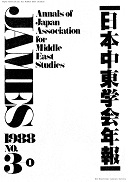The purpose of this thesis is to criticize the theory of the "Mosaic Society" in the field of Middle Eastern area studies through analyzing the process of a disturbance that occurred in Aleppo in the early nineteenth century. Many Orientalists have observed the Middle Eastern society as divided into various religious sects, linguistic groups, quarters, guilds and so on, and they have concluded that there was no unity among them. Sometimes, the antagonism among the population, especially between the religious sects, has been premised in the study of the modern history of the Middle East. Aleppo was the third largest city in the Ottoman Empire at that time, and its population was composed of not only Muslims, but also Christians of various sects and Jews. Turkish, Armenian, Kurdish, and Syriac as well as Arabic were spoken in Aleppo. It is natural that the Orientalists would recognize the city as a typical "Mosaic Society." In order to examine this theory, we employ an urban disturbance as a test. It is not an everyday happening and the social relations that cannot be observed in the description of daily events can be found in the document of the disturbance. In this thesis, a disturbance that continued from October, 1819, to February, 1820, is studied. The date is before the Egyptian occupation of Syria in the 1830's and the Ottoman Tanzimat period. Therefore, the reality of the urban society before the modernization will be described. From the 18th century to the period studied here, there were two strong political factions in Aleppo. One was the Janissaries, the local para-military group, with its followers, and the other was the Ashraf, the people who asserted themselves as the descendants of the Prophet Muhammad, with their followers. The factions opposed each other, competing for political, economic, and social resources, and sometimes struggled violently. However, they did not injure the common people. In the disturbance, which started in the evening of 23 October, 1819, the two factions joined in unity and revolted against the Ottoman governor because of his and his agent's evil policy, heavy taxes and his forces' violence in the city. The rebels attacked the forces' barracks in the city, killed some soldiers and forced the rest to retreat to a monastery that was north of the city where the governor stayed. The a'yan were also expelled or ran away to the same place. The leaders of the two factions assembled, proclaimed the cause of the revolt, and presented their demands to the governor. Here, they shared a common identity, ahl al-balad: people of the town. They organized the people to battle against the governor's forces, and controlled foods and ammunitions in the city. It was besieged by the forces and the supplies were cut. After fierce battles and frequent exchanges of messengers during two months, the division between the factions of Janissaries and Ashraf became clear. However, they did not fight each other and continued battling the forces for a month more. The governor, with reinforcements from many districts, began to destroy houses in the northern suburbs. Finally, the European consuls in the city played the role of mediators and all of the gates of the city were opened on 3 February, 1820. The governor executed and exiled the leaders of the rebels, mainly from the Janissary faction. However, on 2 June, the poor women from the eastern and southern suburb quarters, where most of the Janissary faction lived, rushed to the court of Islamic law and appealed to the judge for help, protesting against the governor's oppressing policy. The judge went to the governor's office and discussed the matter. After that, the heavy extra taxes were abolished and the price of the grain was reduced. After analyzing the process of this disturbance, it becomes clear that not only the two factions but also other people
(View PDF for the rest of the abstract.)
View full abstract
